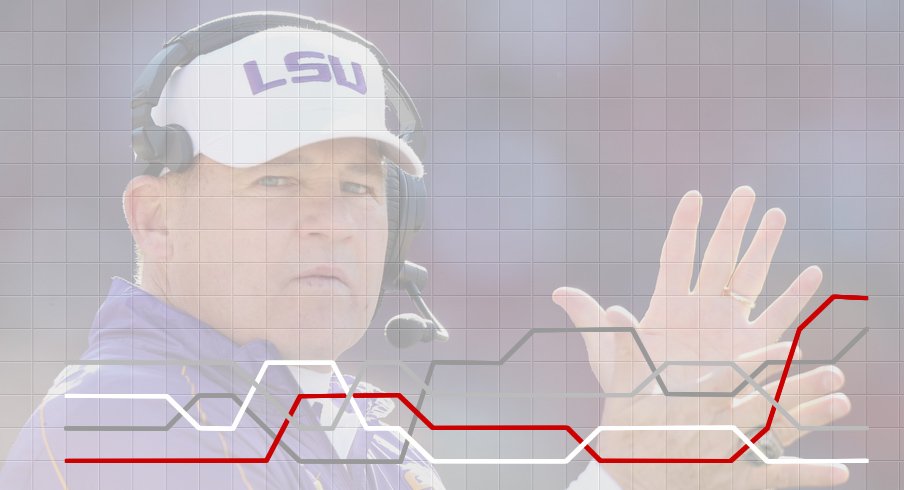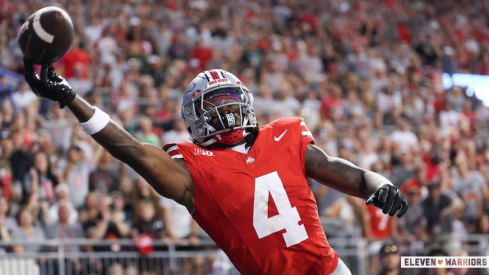In a recurring segment this season, I'll be digging into the ballot behavior of the voters contributing to the AP College Football Poll to see what interests me and what otherwise looks weird. Because this feature runs on Monday, I was not able to get poll data for Week 2 in time. This is because of the ACC's Labor Day Kickoff that pushed the release of the second AP College Football Poll to Tuesday.
So, in this feature, I'll be looking over the past two weeks of ballots for interesting things. If you wish, you can see this raw data for yourself here.
Okay, Who Voted LSU no. 1 Last Week?
On the heels of LSU's 21-point comeback against Wisconsin in its season-opening win in Houston, someone gave LSU a no. 1 vote on his or her ballot the next week. LSU was the preseason no. 13 team and someone gave them a no. 1 vote the next week.
Poking around the AP poll at long last. Had to see what ungodly ballot would include LSU at no. 1. And here it is. pic.twitter.com/ucQVUkxdxN
— Vico (@ourhonordefend) September 6, 2014
That person is Jon Wilner of the Mercury News in San Jose. LSU was the beneficiary of some movement ahead of it (e.g. South Carolina losing to Texas A&M), which moved LSU up one spot to no. 12. Still, a no. 1 vote for a guy who had LSU at no. 16 on the preseason ballot is a bizarre, almost compulsive, change of voting behavior.
Not only is it bizarre, it's on the verge of a statistically impossible vote. To simulate this, I bootstrapped 100,000,000 simulations from a beta distribution with a mean of 12 (LSU's poll position) and a standard deviation of 3 (in which approximately 68% of LSU's votes were between 9 and 15 that week). To make it realistic, I bound the output to 1 and 25. Assuming these parameters on the probability distribution, how likely is a no. 1 vote for LSU?
In my simulation, I got 91 first-place votes for LSU. That's 91 first-place votes of 100,000,000 possible votes between 1 and 25. The probability of a first-place vote for LSU in Week 2 like that cast by Jon Wilner is .00000091.
After Week 3, in which Pac-12 teams Oregon and USC scored impressive wins against quality competition, Wilner reshuffled his ballot to have a top-five of Oregon, Texas A&M, USC, LSU, and Florida State. Texas A&M appeared at no. 2 in Wilner's Week 2 ballot after being unranked by him in the preseason. He also ranks USC highest of anyone else in the poll. Wilner is easily impressed and likes bright, shiny things.
LSU rose two spots in the ranking from Week 2, but consensus about them has also narrowed to a standard deviation of about 2 (in which more than two-thirds of the ballots had LSU between 8 and 12). Thus, the probability of LSU being ranked no. 4 or higher with those parameters is about .002541. We would observe a no. 4 or greater vote about two times out of a thousand trials.
Long story short, Jon Wilner is easily impressed and likes bright, shiny things.
What about Ohio State this Week?
Ohio State took a beating in the polls in Week 3, for which you are probably aware. Previously the AP no. 8 team, Ohio State slid to no. 22 and did not appear in 17 ballots cast by AP voters.
The Buckeyes' highest ranking on any individual ballot was no. 14. Two AP voters (Bob Asmussen, Steve Batterson) cast the Buckeyes at no. 14 after both having the Bucks at no. 7 after Week 2. How unusual are these ballot choices given the poll's consensus?
Answering this question is trickier because the individual-level voter data are censored. For example, Bill Rabinowitz had Ohio State at no. 9 after the first week of the season but did not rank the Buckeyes in his most recent ballot. We know Bill Rabinowitz thought Ohio State was no. 9 last week but do not know what he thinks this week. All we know about Rabinowitz is that Ohio State could have any rank in his opinion between 26 and 125 (the number of teams in FBS).
To compensate, I use a multiple imputation procedure drawing data from a multivariate normal distribution with the following assumptions. First, I assume that any voter not including Ohio State on his or her AP ballot this week has the Buckeyes implicitly ranked between 26 and 43. I make this assumption because there are 43 teams in total that received votes this week.
Further, I assume we can gain predictive leverage over what would be the vote by reference to the voter's ballot for Ohio State last week (in which Ohio State was a consensus top-25 team). There is a statistically discernible association between the two (t = 1.787) for available data. Basically, voters who ranked the Buckeyes higher in Week 2 ranked them higher in Week 3, all else equal.
After generating imputed data, I use the aggregated measures of uncertainty for bootstrapping simulations similar to what I did in gauging the likelihood of LSU's no. 1 vote in Week 2. The probability of Ohio State getting two no. 14 or greater votes in the poll is about .0009. The probability of just one is a more plausible, but still quite improbable, .03.
Voting behavior can be peculiar, especially in small samples.
Others Receiving Votes
The voters were mostly kind to Michigan State, which did not appear to be punished too much for the nature of its loss to Oregon. Garland Gillen had Sparty ranked the lowest at no. 21. Josh Kendall gave Sparty a no. 4 vote.
Nebraska tumbled from the top 25 after the nature of its win against McNeese State, but sits at no. 26. Adam Sparks seemed most forgiving of Nebraska's performance, giving the Huskers a no. 15 vote on his ballot.
Voters have not yet taken the bait on Florida, which has just 70 points in the AP Poll.
Penn State and Iowa are appearing on some ballots now. Iowa's highest ranking is no. 20 (Gary Smits). Chris Murray has Penn State at no. 18.
Two voters have Tennessee on their ballot. One voter—our friend Jon Wilner—has Tennessee at no. 22. Doug Lesmerises has the Vols at no. 16.
Texas Christian has a no. 15 vote (Drew Sharp) and a no. 16 vote (Pete DiPrimio).


